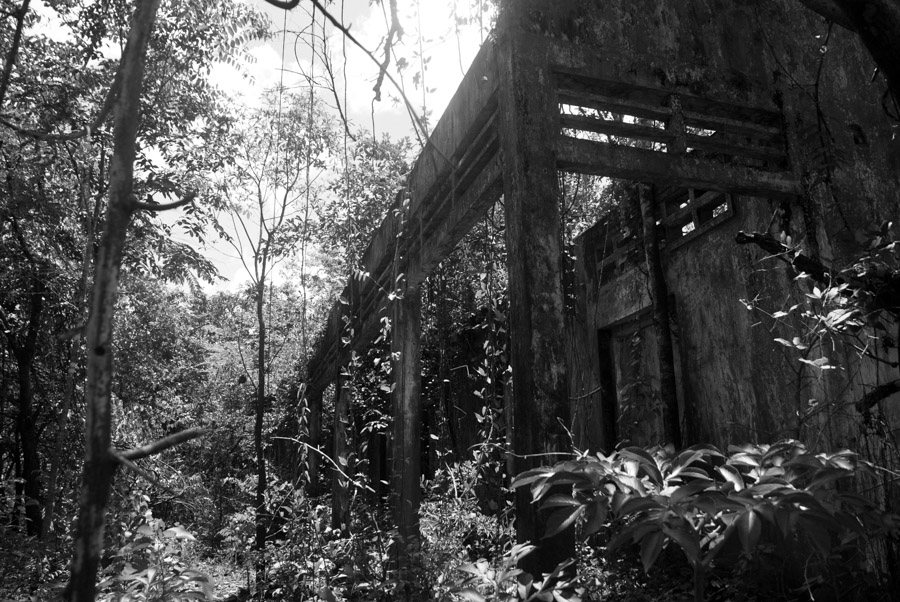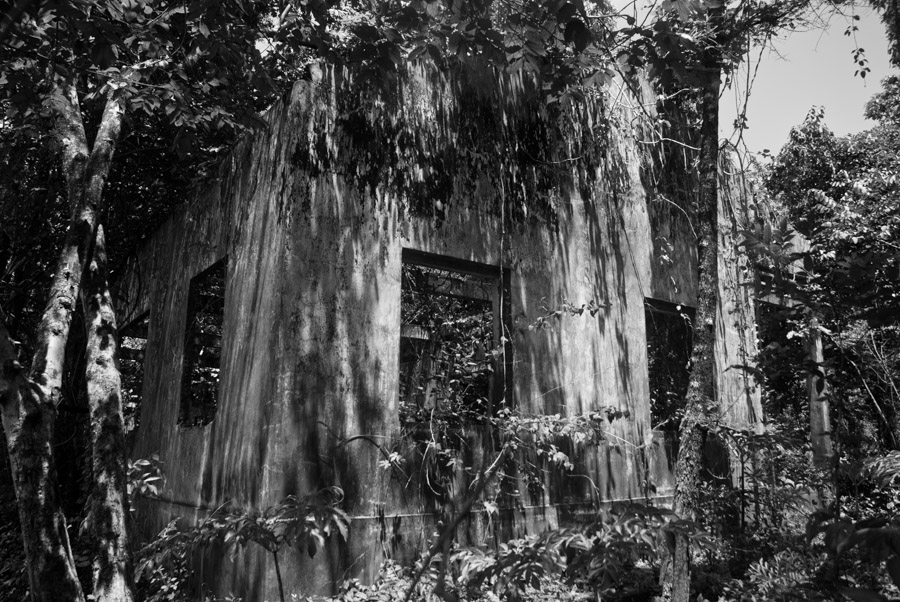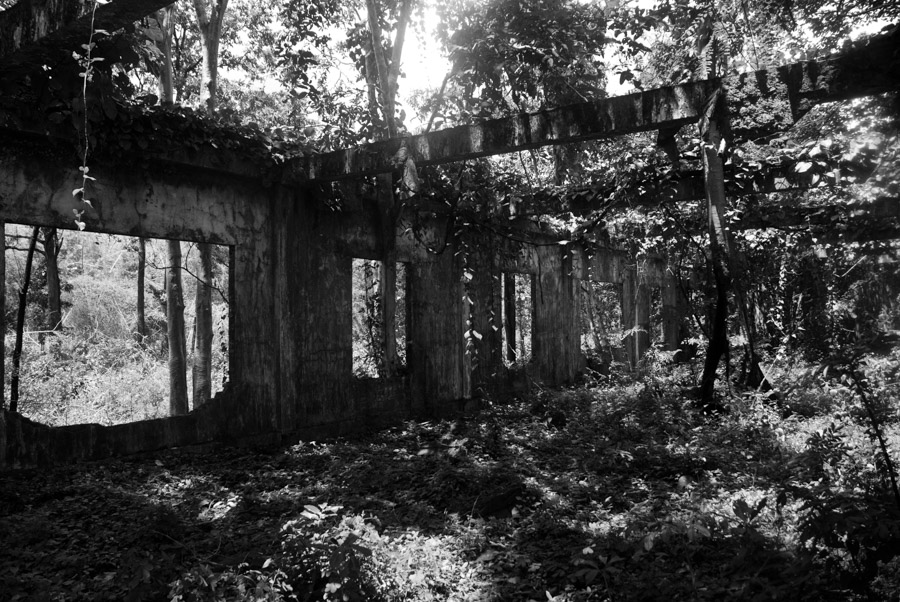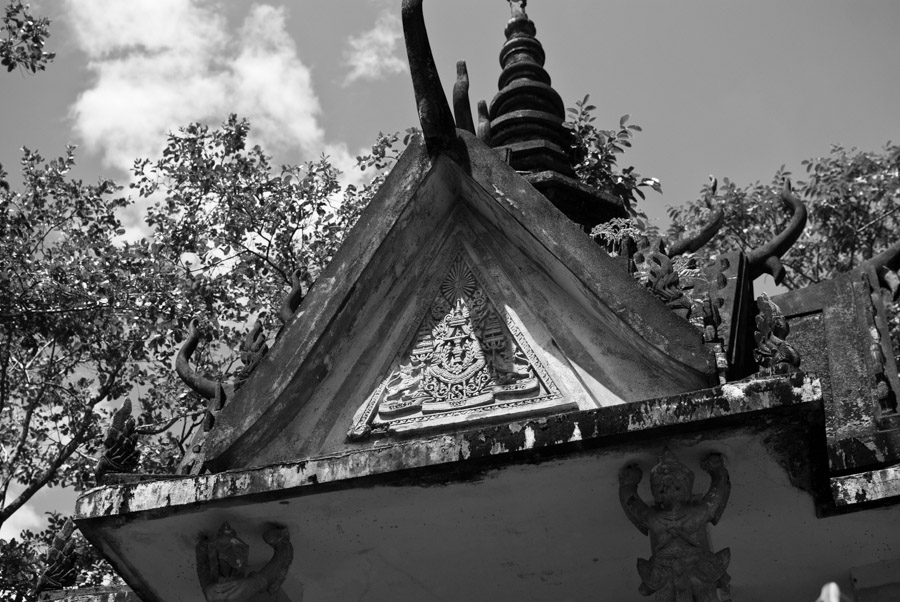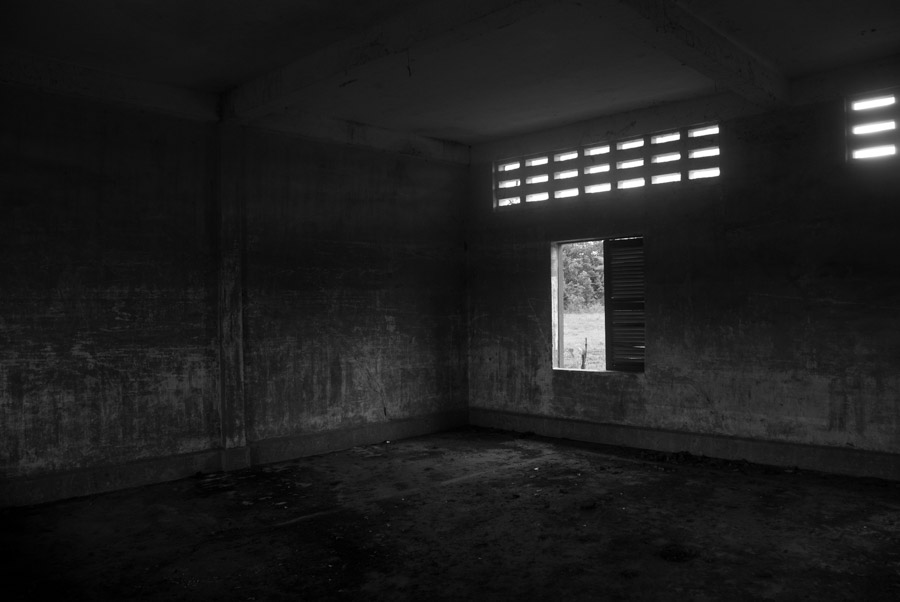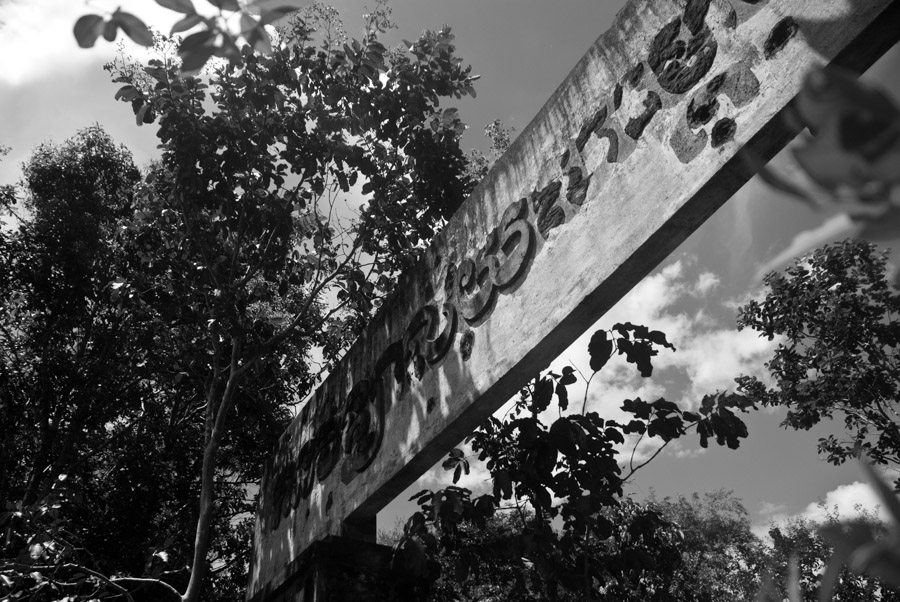
Lumphat seemed forsaken by time. Stretched out along a bend of the Srepok River, this former town was now little more than a village, a mere sprinkling of civilisation in a landscape of red earth and pantone blue skies.
In the 1950s and 1960s, under Prince Norodom Sihanouk, the sleepy hamlet served as the provincial capital of Ratanakiri, an administrative outpost in the northeast of Cambodia. Until the late 1960s, when it was wiped off the map by American B-52 bombings, Lumphat sat at the frontier of the advancing Cambodian state: it had dirt roads laid out in a rough grid, with a Buddhist pagoda, a school and a few government buildings. On maps of the time it was marked by a black dot and, often, by a tiny picture of an aircraft, denoting the rudimentary airstrip that served as its main link to the outside world.
Lumphat never recovered from the bombings and the war, nor from the Khmer Rouge revolution that followed. After the ousting of the Khmer Rouge in 1979, a new provincial capital was established at Banlung, some fifteen kilometres to the north, and Lumphat was left to slumber.
When I visited in 2012, I found a village of a few hundred souls living amid the fading vestiges of the Sihanouk years. At its main intersection — a messy confluence of dirt tracks — there was a small roundabout with jaunty red arrows pointing to the right. There was a water tower, chipped and scarred by shrapnel. Facing onto the Srepok, Wat Aranharam, built in the early 1960s, sat in a yard with a flagpole and weeds that pushed up through the concrete.
I spent some time exploring what was left of the Samdech Eav Junior High School, still marked by a weather-beaten sign on the road. Most of the school buildings had been destroyed during the bombing, their walls wrapped, python-like, by creepers and vines. Just one schoolhouse remained intact, a thick layer of dust covering its chequerboard floor tiles. In the undergrowth nearby, I came across a stupa-like monument with a pointed roof. On its pediments, below the curling eaves, was stamped—shining and optimistic, and somehow still perfectly preserved—the crest of the Cambodian royal family.
The US bombing of Cambodia began in 1965, covertly, as part of an effort to cut off supply routes used by the Vietnamese communists. By 1969, the campaign had expanded into a fully fledged carpet-bombing campaign under the rubric of “Operation Breakfast”. This was followed, in due course, by a euphemistic “Menu”, comprising “Lunch”, “Snack”, “Dinner”, “Supper” and “Dessert”. After that began “Operation Freedom Deal”, which continued right up until the bombing campaign was halted by Congress in August 1973.
By then, the US had dropped more than 500,000 tons of ordnance on Cambodia, around the same that it dropped in the Pacific theatre during the Second World War. While academics and journalists have debated the death toll from the aerial bombings that destroyed towns like Lumphat — estimates run from 10,000 to more than half a million — and the question of the role they played in bringing the Khmer Rouge to power in 1975, they devastated wide swathes of the Cambodian countryside, driving thousands of rural folk from their land and scarring the landscape with lines of circular craters that can still be seen today.
More than four decades on, the history of the American bombing continues to bedevil Cambodia’s relationship with the United States. Tensions flare up over the issue every few years, usually in connection with the vexed question of whether Cambodia should pay back a $274 million loan that Washington made to the pro-US republican regime of General Lon Nol. Cambodia has refused to repay the loan, which was intended to help the government clothe and feed its people in the early 1970s, including many of those displaced by the bombing. In the years since, interest has swelled it to more than half a billion dollars.
From Washington’s perspective, the issue is simple: debts are debts, and exceptions can be made only by an explicit act of Congress. Cambodian officials counter that it is morally outrageous to ask them to repay a debt contracted by an illegal government (Lon Nol came to power in a coup d’état in 1970), in the course of a war that brought its people so much destruction. If either side is owed anything, the argument runs, it is Cambodia. As the country’s Prime Minister Hun Sen put it in a speech last year, “It is difficult for us to tell Cambodians to accept debt [that was used] to buy bombs and bullets to kill Cambodian people”.
Hun Sen, needless to say, is no dispassionate seeker of truth. Since becoming prime minister in 1985, he has picked up this history, twisted it about and wielded it as a cudgel against any critics of his government or its transgressions. He has revisited the issue with successive American administrations, testing their resolve with aggressive references to past US actions. (His latest outburst was timed to the inauguration of President Donald Trump.) But for Hun Sen, the political is also personal. Growing up in Kampong Cham in the 1960s, he personally experienced the terror of the B-52 thunder, subsequently joining the communist insurgency in order to fight the “imperialism” of the US-backed Lon Nol government.
Later, when Hun Sen defected from the Khmer Rouge military and helped overthrow the murderous regime in 1979, the new government of which he was part found itself embargoed and isolated by the US and its allies — precisely for having toppled Pol Pot. Until 1990, bipolar Cold War logic dictated that the US allow the Khmer Rouge to continue to occupy Cambodia’s seat at the United Nations (it finally vacated the seat in 1991), while support from its new-found ally China kept the movement alive in its bases along the Thai border. As the late Zbigniew Brzezinski, President Carter’s national security adviser, explained it in 1985, the logic of US policy was to provide the political cover for Beijing to back Pol Pot’s movement in order to bleed Communist Vietnam. “Pol Pot was an abomination,” he said. “We could never support him, but China could.”
The Paris Peace Agreements, signed in October 1991 by Hun Sen’s government and three armed resistance factions, were supposed to bring an end to this tortured geopolitical alignment. In one sense, they succeeded: the superpowers detached themselves from Cambodia’s internal affairs, and the country emerged, after United Nations-organised elections in 1993, under the control of a single, universally recognised government. Despite the agreement, profound misunderstandings lingered.
More than four decades on, the history of the American bombing continues to bedevil Cambodia’s relationship with the United States.
For many US officials, the Paris Agreements and the end of the Cold War allowed an opportunity to draw a line under an uncomfortable chapter in the story of US empire. In the dawning post-Cold War order, the US would make amends for past actions by contributing to the country’s reconstruction and giving Cambodia the greatest gift of all: democracy. For Hun Sen and his colleagues, the new status quo was built on a colossal hypocrisy. The Cambodian People’s Party — formerly the Kampuchean People’s Revolutionary Party — was the one Cambodian faction that had played any role in the overthrow of the Khmer Rouge, and was therefore the one Cambodian faction with any right to rule the country. And after the experience of the 1980s, it saw democracy not as a gift from the West, but as an instrument for removing it from power.
Hun Sen sparred with US officials repeatedly throughout the 1990s, when the US — or more specifically, its Congress — emerged as one of the most outspoken critics of his government. However principled these criticisms might be — and there was plenty to criticise in the 1990s, a time of simmering civil war and violence in the streets — the Cambodian leader always stood ready to hurl history back in their faces. In 1995, in just one of many reactions to his US critics, Hun Sen gave a speech in which he threatened anti-US demonstrations and called for reparations for the US bombings of the 1960s and 1970s. “How much?”, he asked his audience sarcastically. “Only about $20 billion.”
***
By temperament, Americans are forward-looking and optimistic — perhaps overly so. Gore Vidal once wrote that the past, for his compatriots, was “a separate universe with its own quaint laws and irrelevant perceptions”. Whether or not this is the case in general, it is certainly so in the case of Cambodia, a faraway nation that the US government has never understood — or even really tried to understand — on its own terms.
It’s also true that the American political and pundit class, caught up in the quadrennial churn of the presidential cycle, moves on quickly from the wars and interventions of the past. The war in Indochina might have been a terrible mistake, but it is now firmly in the rear-view mirror, confined to the museum realm of the done-and-dusted. Whatever our past mistakes, this past is of only glancing relevance to the present. (And in any case, our intentions were good.)
The United States has always affected a certain aloofness from history. As the theologian Reinhold Niebuhr wrote in The Irony of American History, the US was born at the height of the Enlightenment with the sense of being a “‘separated’ nation, which God was using to make a new beginning for mankind”. Armed with a universal mission, Americans could contemplate interventions in far-off lands while thinking of themselves not as potential masters — successors to the European colonial enterprise — “but as tutors of mankind in its pilgrimage to perfection”. Within this architecture of good intentions, it is easy to see how US officials could pursue a policy of supporting a regime like the Khmer Rouge until 1990, and then turn around and lecture Cambodian leaders about accountability in 1994.
Cambodia, on the other hand, remains less able to transcend its history. It has neither the wealth and power of the United States, nor the continental basis of its optimism (“from sea to shining sea”). It reminds me of historian Garry Wills’ description of the South — the one part of the US to have known real defeat. Wills wrote that the South escaped “one of the worst character traits of America, its sappy optimism, its weakness of positive thinking. The North puffed confidently into the future, Panglossian about progress, always bound to win. But the South had lost. It knew there was an America that could be defeated.”
Cambodia has known defeat and decline — and devastation, too, worse even than that visited upon the South during Sherman’s march to the sea. For centuries it has sat amid an awkward geography, with few natural borders, its survival always in question in the face of repeated foreign interventions. Perhaps it is no surprise that, when seeking to explain his country’s recent history, Youk Chhang, the director of the US-funded Documentation Center of Cambodia, frequently reaches for William Faulkner, a Southern author: “The past isn’t dead. It’s not even past.” A more immediate reason that Cambodia’s history remains so current is that most of Cambodia’s political class came of age in the 1960s, steeped in an anti-colonial tradition that continues to dominate the country’s politics today. (Despite approaching the end of his thirty-second year in power, Hun Sen will be just sixty-five this year).
No matter how much Washington wants to put the history of the Cold War behind it, then, it remains alive for Cambodia’s government, making it difficult for the US to separate its criticisms of the CPP government from American actions of the recent past. The reason Hun Sen returns again and again to the history of the US bombing of the 1960s and 1970s is that it is both politically effective and morally unanswerable. As bad as it is and has been, what has his government done that comes even close to the devastation of “Operation Freedom Deal”?
One quirk of recent Cambodian history is that the country has been held to a different, higher standard than its neighbours; such are the wages, I suppose, of having been an international nation-building “project”. For Hun Sen’s critics in the US, Cambodian history often seems as if it began in Paris in 1991, when his government was offered, and spurned, the gift of democracy. But for these standards to remain morally tenable, they need to be balanced by the backstory. Forgiving the Cambodian debt of the early 1970s would go at least some way towards rebalancing the moral ledger. Cambodia’s pugnacious strongman has few friends in Washington, but US officials need to realise that it is possible to be right for the wrong reasons. At the end of the Cold War, the United States drew a line under its own history in Cambodia. It’s well past time for it to extend that line in the other direction as well.
Published in The Mekong Review, July-September 2017.

